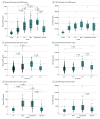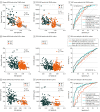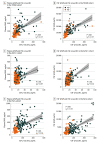Differences Between Plasma and Cerebrospinal Fluid Glial Fibrillary Acidic Protein Levels Across the Alzheimer Disease Continuum
- PMID: 34661615
- PMCID: PMC8524356
- DOI: 10.1001/jamaneurol.2021.3671
Differences Between Plasma and Cerebrospinal Fluid Glial Fibrillary Acidic Protein Levels Across the Alzheimer Disease Continuum
Abstract
Importance: Glial fibrillary acidic protein (GFAP) is a marker of reactive astrogliosis that increases in the cerebrospinal fluid (CSF) and blood of individuals with Alzheimer disease (AD). However, it is not known whether there are differences in blood GFAP levels across the entire AD continuum and whether its performance is similar to that of CSF GFAP.
Objective: To evaluate plasma GFAP levels throughout the entire AD continuum, from preclinical AD to AD dementia, compared with CSF GFAP.
Design, setting, and participants: This observational, cross-sectional study collected data from July 29, 2014, to January 31, 2020, from 3 centers. The Translational Biomarkers in Aging and Dementia (TRIAD) cohort (Montreal, Canada) included individuals in the entire AD continuum. Results were confirmed in the Alzheimer's and Families (ALFA+) study (Barcelona, Spain), which included individuals with preclinical AD, and the BioCogBank Paris Lariboisière cohort (Paris, France), which included individuals with symptomatic AD.
Main outcomes and measures: Plasma and CSF GFAP levels measured with a Simoa assay were the main outcome. Other measurements included levels of CSF amyloid-β 42/40 (Aβ42/40), phosphorylated tau181 (p-tau181), neurofilament light (NfL), Chitinase-3-like protein 1 (YKL40), and soluble triggering receptor expressed on myeloid cells 2 (sTREM2) and levels of plasma p-tau181 and NfL. Results of amyloid positron emission tomography (PET) were available in TRIAD and ALFA+, and results of tau PET were available in TRIAD.
Results: A total of 300 TRIAD participants (177 women [59.0%]; mean [SD] age, 64.6 [17.6] years), 384 ALFA+ participants (234 women [60.9%]; mean [SD] age, 61.1 [4.7] years), and 187 BioCogBank Paris Lariboisière participants (116 women [62.0%]; mean [SD] age, 69.9 [9.2] years) were included. Plasma GFAP levels were significantly higher in individuals with preclinical AD in comparison with cognitively unimpaired (CU) Aβ-negative individuals (TRIAD: Aβ-negative mean [SD], 185.1 [93.5] pg/mL, Aβ-positive mean [SD], 285.0 [142.6] pg/mL; ALFA+: Aβ-negative mean [SD], 121.9 [42.4] pg/mL, Aβ-positive mean [SD], 169.9 [78.5] pg/mL). Plasma GFAP levels were also higher among individuals in symptomatic stages of the AD continuum (TRIAD: CU Aβ-positive mean [SD], 285.0 [142.6] pg/mL, mild cognitive impairment [MCI] Aβ-positive mean [SD], 332.5 [153.6] pg/mL; AD mean [SD], 388.1 [152.8] pg/mL vs CU Aβ-negative mean [SD], 185.1 [93.5] pg/mL; Paris: MCI Aβ-positive, mean [SD], 368.6 [158.5] pg/mL; AD dementia, mean [SD], 376.4 [179.6] pg/mL vs CU Aβ-negative mean [SD], 161.2 [67.1] pg/mL). Plasma GFAP magnitude changes were consistently higher than those of CSF GFAP. Plasma GFAP more accurately discriminated Aβ-positive from Aβ-negative individuals than CSF GFAP (area under the curve for plasma GFAP, 0.69-0.86; area under the curve for CSF GFAP, 0.59-0.76). Moreover, plasma GFAP levels were positively associated with tau pathology only among individuals with concomitant Aβ pathology.
Conclusions and relevance: This study suggests that plasma GFAP is a sensitive biomarker for detecting and tracking reactive astrogliosis and Aβ pathology even among individuals in the early stages of AD.
Conflict of interest statement
Figures



References
-
- Thijssen EH, La Joie R, Wolf A, et al. ; Advancing Research and Treatment for Frontotemporal Lobar Degeneration (ARTFL) investigators . Diagnostic value of plasma phosphorylated tau181 in Alzheimer’s disease and frontotemporal lobar degeneration. Nat Med. 2020;26(3):387-397. doi:10.1038/s41591-020-0762-2 - DOI - PMC - PubMed
-
- Lantero Rodriguez J, Karikari TK, Suárez-Calvet M, et al. . Plasma p-tau181 accurately predicts Alzheimer’s disease pathology at least 8 years prior to post-mortem and improves the clinical characterisation of cognitive decline. Acta Neuropathol. 2020;140(3):267-278. doi:10.1007/s00401-020-02195-x - DOI - PMC - PubMed
Publication types
MeSH terms
Substances
LinkOut - more resources
Full Text Sources
Medical
Research Materials
Miscellaneous

